Comprehensive Report on Aspects of Contracts in Business Law
VerifiedAdded on 2020/01/28
|11
|3338
|43
Report
AI Summary
This report provides a comprehensive overview of the aspects of contracts within a business context. It begins by outlining the fundamental elements of a valid contract, including offer, acceptance, intention, capacity, and consideration. The report then explores different types of contracts, such as oral, written, bilateral, and distance selling contracts, and analyzes their impacts. Through real-world scenarios, the report illustrates the application of contract principles and the consequences of breach. Furthermore, it delves into contract terms, including conditions, warranties, and exclusion clauses, and examines the concept of negligence within the framework of tort law. The report differentiates between contractual and tort liabilities and provides insights into the landmark case of 'Donoghue v Stevenson,' highlighting the importance of duty of care and breach of duty. Finally, the report discusses the roles of employers and employees in business contracts and liabilities.
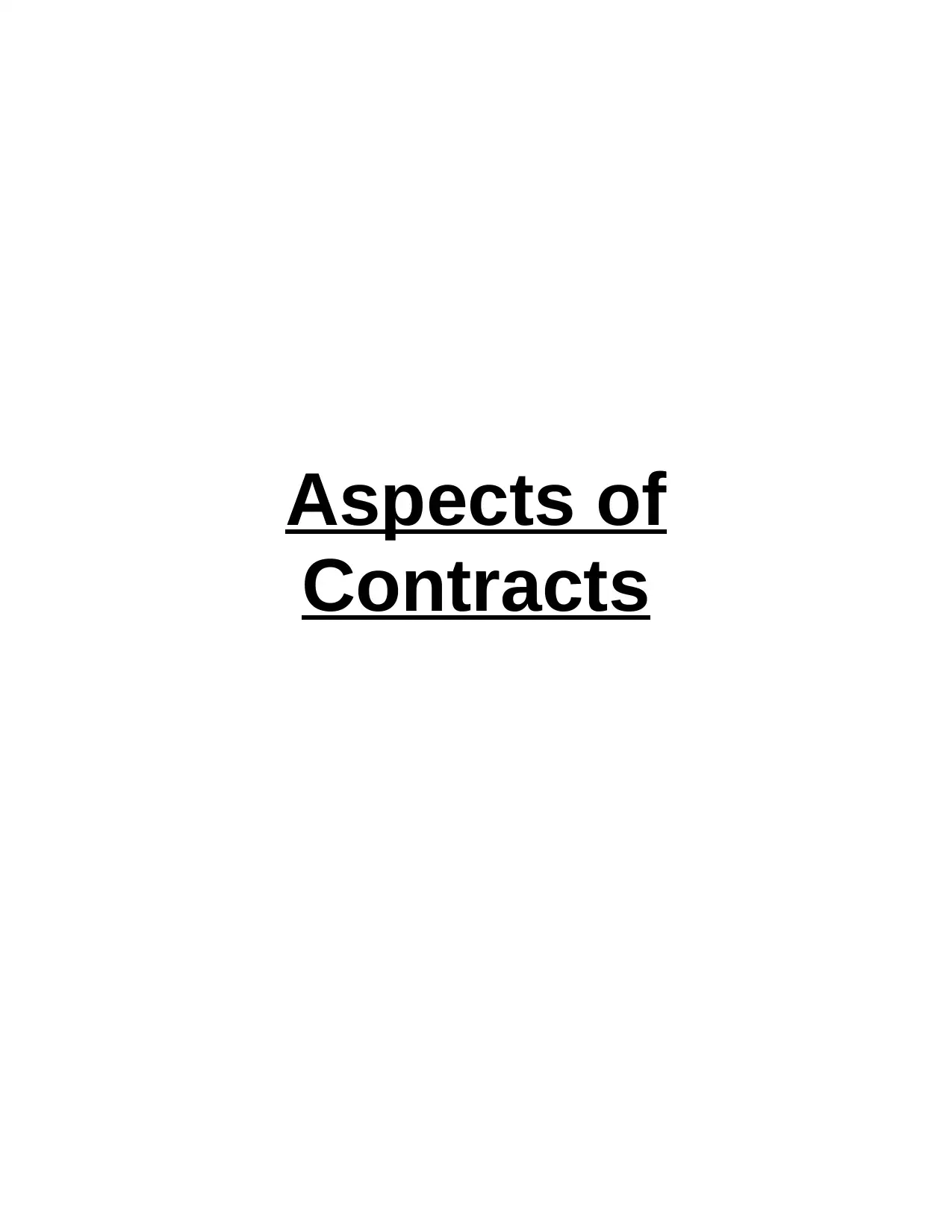
Aspects of
Contracts
Contracts
Paraphrase This Document
Need a fresh take? Get an instant paraphrase of this document with our AI Paraphraser
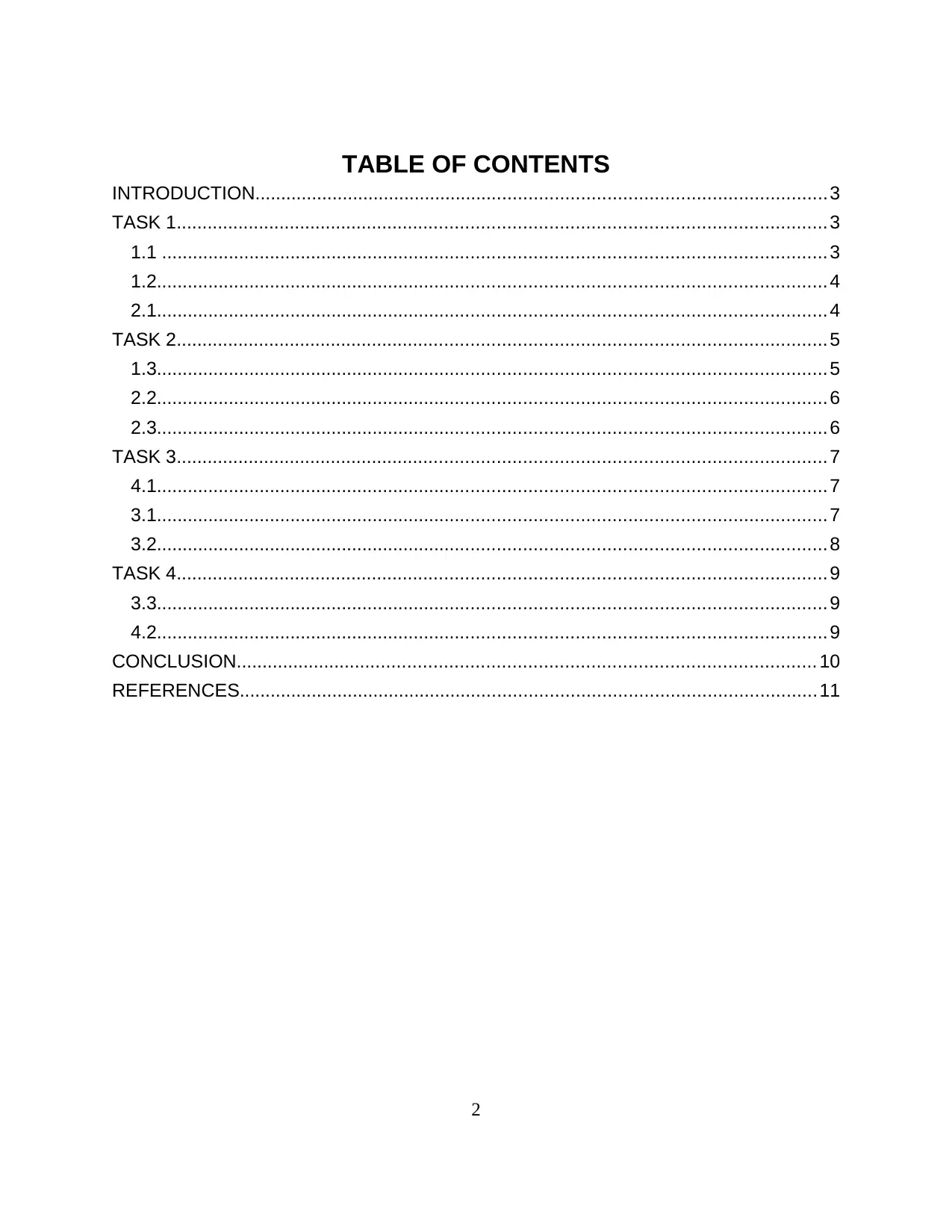
TABLE OF CONTENTS
INTRODUCTION..............................................................................................................3
TASK 1.............................................................................................................................3
1.1 ................................................................................................................................3
1.2.................................................................................................................................4
2.1.................................................................................................................................4
TASK 2.............................................................................................................................5
1.3.................................................................................................................................5
2.2.................................................................................................................................6
2.3.................................................................................................................................6
TASK 3.............................................................................................................................7
4.1.................................................................................................................................7
3.1.................................................................................................................................7
3.2.................................................................................................................................8
TASK 4.............................................................................................................................9
3.3.................................................................................................................................9
4.2.................................................................................................................................9
CONCLUSION............................................................................................................... 10
REFERENCES...............................................................................................................11
2
INTRODUCTION..............................................................................................................3
TASK 1.............................................................................................................................3
1.1 ................................................................................................................................3
1.2.................................................................................................................................4
2.1.................................................................................................................................4
TASK 2.............................................................................................................................5
1.3.................................................................................................................................5
2.2.................................................................................................................................6
2.3.................................................................................................................................6
TASK 3.............................................................................................................................7
4.1.................................................................................................................................7
3.1.................................................................................................................................7
3.2.................................................................................................................................8
TASK 4.............................................................................................................................9
3.3.................................................................................................................................9
4.2.................................................................................................................................9
CONCLUSION............................................................................................................... 10
REFERENCES...............................................................................................................11
2

INTRODUCTION
Aspects of contracts is an important study required for developing a
understanding for the basics of law. Any business organisation develops all its
strategies and action plans according to the laws and regulations that are formulated by
the government. There are certain criteria that have to be taken care before and after
entering the real time markets. The organisations that abide by the law do not face any
criticism or negative publicity while the rule breakers are always in the limelight.
Contracts are the building blocks of business functioning. It is a form of consent that is
brought up according to the needs of the individual for their respective benefits. This
report aims to gather understanding for the aspects of contracts and negligence in
business.
TASK 1
1.1
According to the laws in UK, every valid contract has certain basic elements that
have to be mentioned. These are mentioned as follows:
1. Offer: When one party extends its interests views towards another party then a
proposal is made which is also known as an offer. The offer has to be clearly
communicated to the second party as well as the complications must be clear
because the offer is the first step for business contract (Sherwin, 2015).
2. Acceptance: After the deliverance of the offer, if the second party accepts it
positively then, the process is acceptance. If the second party negotiates over
the terms of the offer then, it is not acceptance.
3. Intention: The intention behind the contract is to be declared for making it legal.
Any hidden causes or motives undeclared can indicate negative intentions.
4. Capacity: A contract is valid and legal enough if, the person or individuals who
are involved in the contract process are in the viable age as well as completely
healthy from their mind and body. But individuals with any sort of impairments be
it physical or mental and their involvement in a contract form a illegal or invalid
contract (Miller, 2013).
3
Aspects of contracts is an important study required for developing a
understanding for the basics of law. Any business organisation develops all its
strategies and action plans according to the laws and regulations that are formulated by
the government. There are certain criteria that have to be taken care before and after
entering the real time markets. The organisations that abide by the law do not face any
criticism or negative publicity while the rule breakers are always in the limelight.
Contracts are the building blocks of business functioning. It is a form of consent that is
brought up according to the needs of the individual for their respective benefits. This
report aims to gather understanding for the aspects of contracts and negligence in
business.
TASK 1
1.1
According to the laws in UK, every valid contract has certain basic elements that
have to be mentioned. These are mentioned as follows:
1. Offer: When one party extends its interests views towards another party then a
proposal is made which is also known as an offer. The offer has to be clearly
communicated to the second party as well as the complications must be clear
because the offer is the first step for business contract (Sherwin, 2015).
2. Acceptance: After the deliverance of the offer, if the second party accepts it
positively then, the process is acceptance. If the second party negotiates over
the terms of the offer then, it is not acceptance.
3. Intention: The intention behind the contract is to be declared for making it legal.
Any hidden causes or motives undeclared can indicate negative intentions.
4. Capacity: A contract is valid and legal enough if, the person or individuals who
are involved in the contract process are in the viable age as well as completely
healthy from their mind and body. But individuals with any sort of impairments be
it physical or mental and their involvement in a contract form a illegal or invalid
contract (Miller, 2013).
3
⊘ This is a preview!⊘
Do you want full access?
Subscribe today to unlock all pages.

Trusted by 1+ million students worldwide
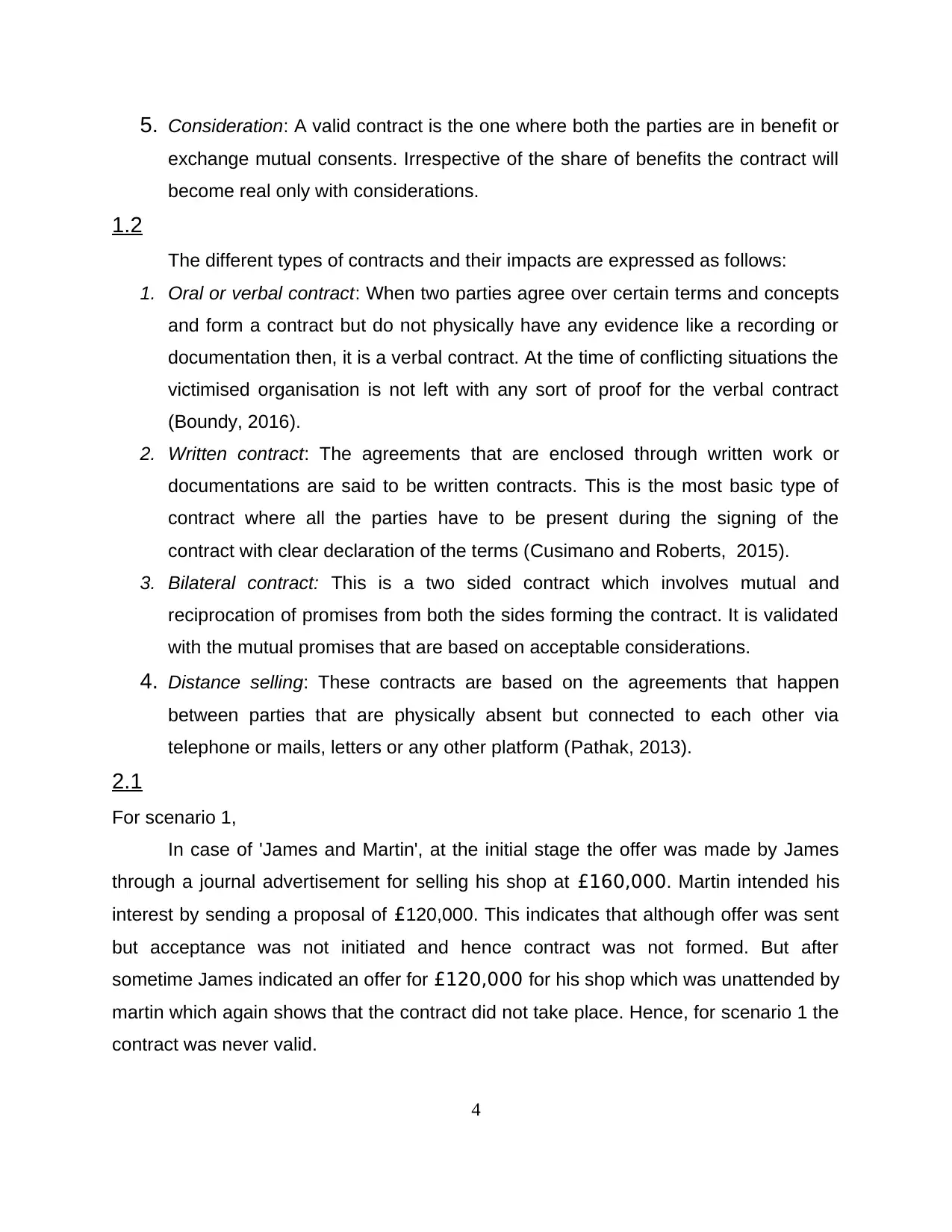
5. Consideration: A valid contract is the one where both the parties are in benefit or
exchange mutual consents. Irrespective of the share of benefits the contract will
become real only with considerations.
1.2
The different types of contracts and their impacts are expressed as follows:
1. Oral or verbal contract: When two parties agree over certain terms and concepts
and form a contract but do not physically have any evidence like a recording or
documentation then, it is a verbal contract. At the time of conflicting situations the
victimised organisation is not left with any sort of proof for the verbal contract
(Boundy, 2016).
2. Written contract: The agreements that are enclosed through written work or
documentations are said to be written contracts. This is the most basic type of
contract where all the parties have to be present during the signing of the
contract with clear declaration of the terms (Cusimano and Roberts, 2015).
3. Bilateral contract: This is a two sided contract which involves mutual and
reciprocation of promises from both the sides forming the contract. It is validated
with the mutual promises that are based on acceptable considerations.
4. Distance selling: These contracts are based on the agreements that happen
between parties that are physically absent but connected to each other via
telephone or mails, letters or any other platform (Pathak, 2013).
2.1
For scenario 1,
In case of 'James and Martin', at the initial stage the offer was made by James
through a journal advertisement for selling his shop at £160,000. Martin intended his
interest by sending a proposal of £120,000. This indicates that although offer was sent
but acceptance was not initiated and hence contract was not formed. But after
sometime James indicated an offer for £120,000 for his shop which was unattended by
martin which again shows that the contract did not take place. Hence, for scenario 1 the
contract was never valid.
4
exchange mutual consents. Irrespective of the share of benefits the contract will
become real only with considerations.
1.2
The different types of contracts and their impacts are expressed as follows:
1. Oral or verbal contract: When two parties agree over certain terms and concepts
and form a contract but do not physically have any evidence like a recording or
documentation then, it is a verbal contract. At the time of conflicting situations the
victimised organisation is not left with any sort of proof for the verbal contract
(Boundy, 2016).
2. Written contract: The agreements that are enclosed through written work or
documentations are said to be written contracts. This is the most basic type of
contract where all the parties have to be present during the signing of the
contract with clear declaration of the terms (Cusimano and Roberts, 2015).
3. Bilateral contract: This is a two sided contract which involves mutual and
reciprocation of promises from both the sides forming the contract. It is validated
with the mutual promises that are based on acceptable considerations.
4. Distance selling: These contracts are based on the agreements that happen
between parties that are physically absent but connected to each other via
telephone or mails, letters or any other platform (Pathak, 2013).
2.1
For scenario 1,
In case of 'James and Martin', at the initial stage the offer was made by James
through a journal advertisement for selling his shop at £160,000. Martin intended his
interest by sending a proposal of £120,000. This indicates that although offer was sent
but acceptance was not initiated and hence contract was not formed. But after
sometime James indicated an offer for £120,000 for his shop which was unattended by
martin which again shows that the contract did not take place. Hence, for scenario 1 the
contract was never valid.
4
Paraphrase This Document
Need a fresh take? Get an instant paraphrase of this document with our AI Paraphraser
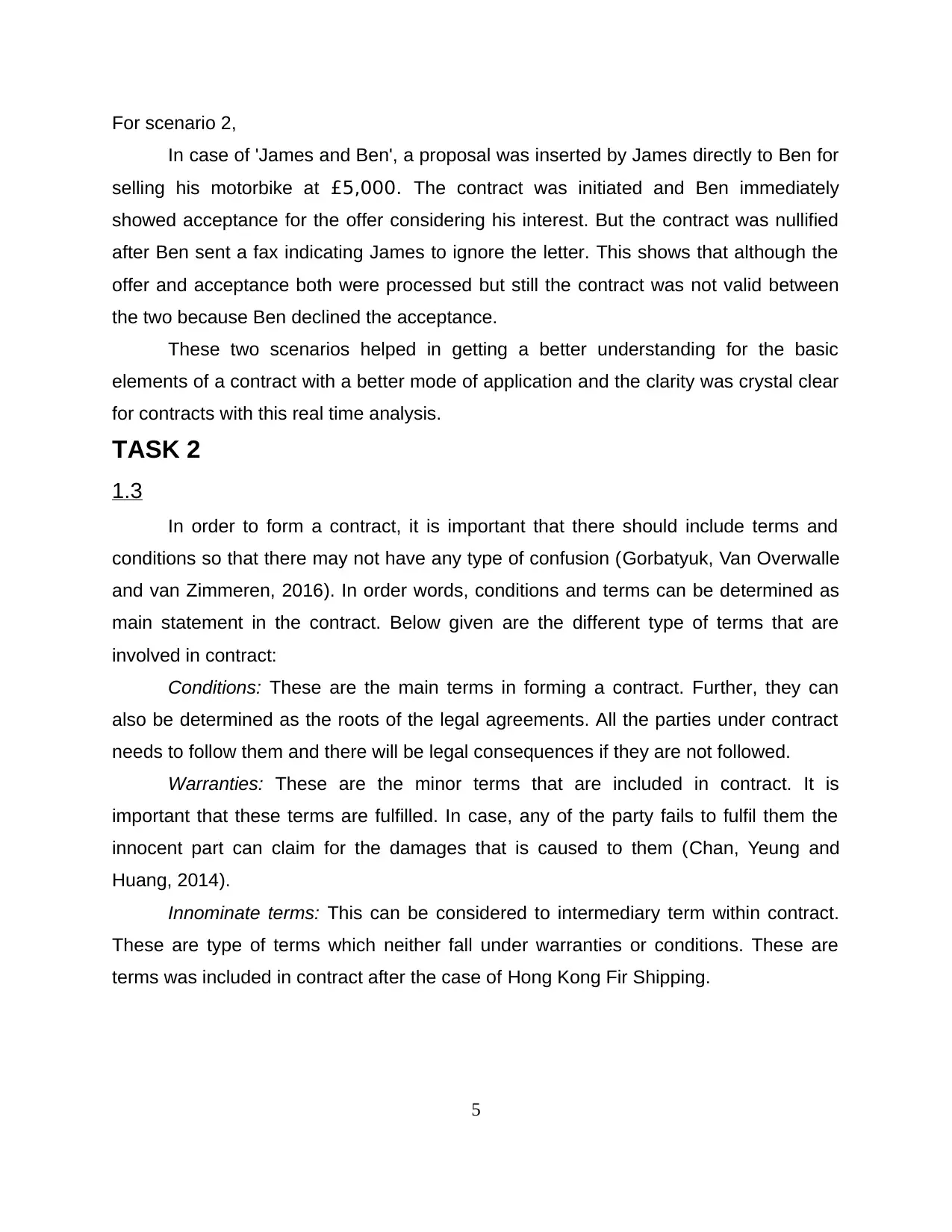
For scenario 2,
In case of 'James and Ben', a proposal was inserted by James directly to Ben for
selling his motorbike at £5,000. The contract was initiated and Ben immediately
showed acceptance for the offer considering his interest. But the contract was nullified
after Ben sent a fax indicating James to ignore the letter. This shows that although the
offer and acceptance both were processed but still the contract was not valid between
the two because Ben declined the acceptance.
These two scenarios helped in getting a better understanding for the basic
elements of a contract with a better mode of application and the clarity was crystal clear
for contracts with this real time analysis.
TASK 2
1.3
In order to form a contract, it is important that there should include terms and
conditions so that there may not have any type of confusion (Gorbatyuk, Van Overwalle
and van Zimmeren, 2016). In order words, conditions and terms can be determined as
main statement in the contract. Below given are the different type of terms that are
involved in contract:
Conditions: These are the main terms in forming a contract. Further, they can
also be determined as the roots of the legal agreements. All the parties under contract
needs to follow them and there will be legal consequences if they are not followed.
Warranties: These are the minor terms that are included in contract. It is
important that these terms are fulfilled. In case, any of the party fails to fulfil them the
innocent part can claim for the damages that is caused to them (Chan, Yeung and
Huang, 2014).
Innominate terms: This can be considered to intermediary term within contract.
These are type of terms which neither fall under warranties or conditions. These are
terms was included in contract after the case of Hong Kong Fir Shipping.
5
In case of 'James and Ben', a proposal was inserted by James directly to Ben for
selling his motorbike at £5,000. The contract was initiated and Ben immediately
showed acceptance for the offer considering his interest. But the contract was nullified
after Ben sent a fax indicating James to ignore the letter. This shows that although the
offer and acceptance both were processed but still the contract was not valid between
the two because Ben declined the acceptance.
These two scenarios helped in getting a better understanding for the basic
elements of a contract with a better mode of application and the clarity was crystal clear
for contracts with this real time analysis.
TASK 2
1.3
In order to form a contract, it is important that there should include terms and
conditions so that there may not have any type of confusion (Gorbatyuk, Van Overwalle
and van Zimmeren, 2016). In order words, conditions and terms can be determined as
main statement in the contract. Below given are the different type of terms that are
involved in contract:
Conditions: These are the main terms in forming a contract. Further, they can
also be determined as the roots of the legal agreements. All the parties under contract
needs to follow them and there will be legal consequences if they are not followed.
Warranties: These are the minor terms that are included in contract. It is
important that these terms are fulfilled. In case, any of the party fails to fulfil them the
innocent part can claim for the damages that is caused to them (Chan, Yeung and
Huang, 2014).
Innominate terms: This can be considered to intermediary term within contract.
These are type of terms which neither fall under warranties or conditions. These are
terms was included in contract after the case of Hong Kong Fir Shipping.
5
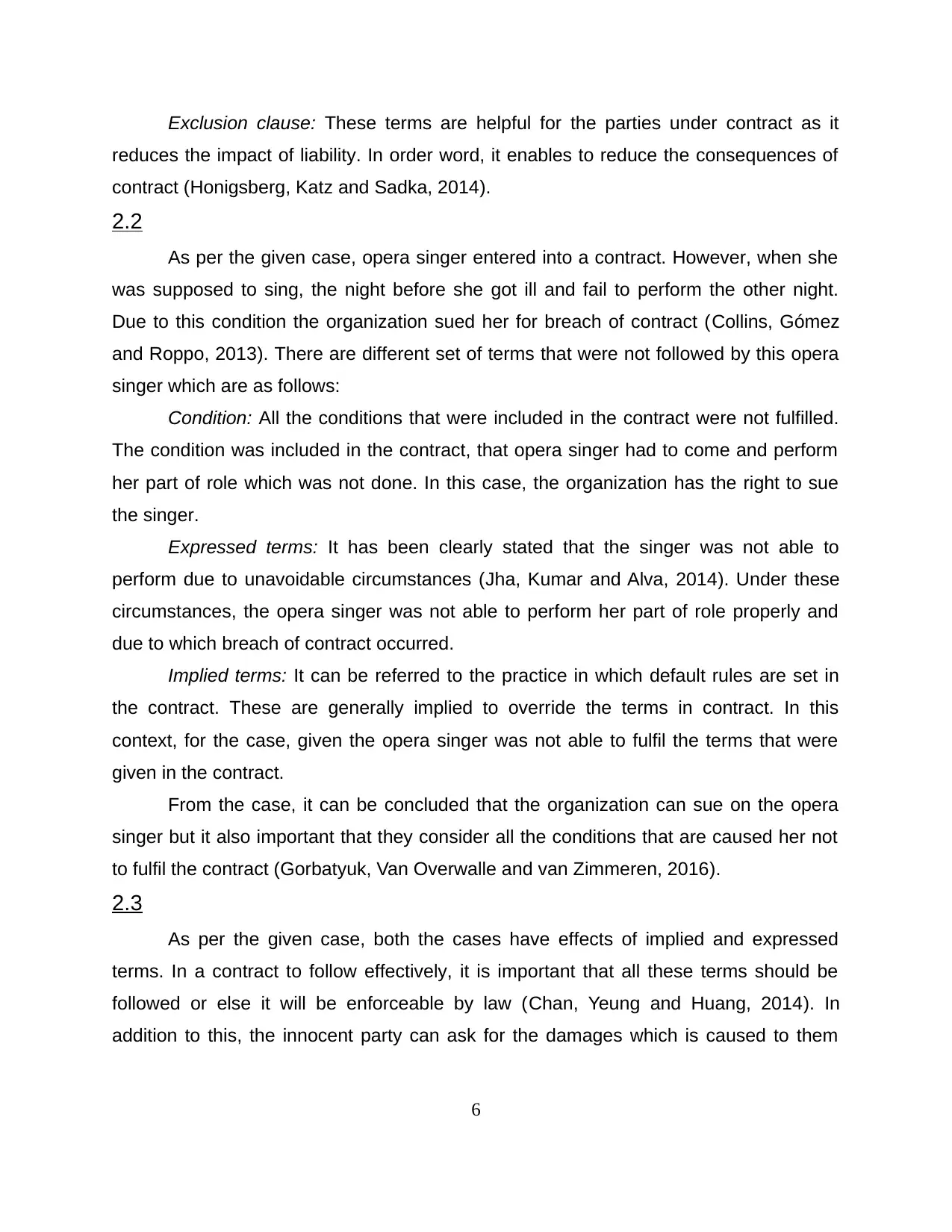
Exclusion clause: These terms are helpful for the parties under contract as it
reduces the impact of liability. In order word, it enables to reduce the consequences of
contract (Honigsberg, Katz and Sadka, 2014).
2.2
As per the given case, opera singer entered into a contract. However, when she
was supposed to sing, the night before she got ill and fail to perform the other night.
Due to this condition the organization sued her for breach of contract (Collins, Gómez
and Roppo, 2013). There are different set of terms that were not followed by this opera
singer which are as follows:
Condition: All the conditions that were included in the contract were not fulfilled.
The condition was included in the contract, that opera singer had to come and perform
her part of role which was not done. In this case, the organization has the right to sue
the singer.
Expressed terms: It has been clearly stated that the singer was not able to
perform due to unavoidable circumstances (Jha, Kumar and Alva, 2014). Under these
circumstances, the opera singer was not able to perform her part of role properly and
due to which breach of contract occurred.
Implied terms: It can be referred to the practice in which default rules are set in
the contract. These are generally implied to override the terms in contract. In this
context, for the case, given the opera singer was not able to fulfil the terms that were
given in the contract.
From the case, it can be concluded that the organization can sue on the opera
singer but it also important that they consider all the conditions that are caused her not
to fulfil the contract (Gorbatyuk, Van Overwalle and van Zimmeren, 2016).
2.3
As per the given case, both the cases have effects of implied and expressed
terms. In a contract to follow effectively, it is important that all these terms should be
followed or else it will be enforceable by law (Chan, Yeung and Huang, 2014). In
addition to this, the innocent party can ask for the damages which is caused to them
6
reduces the impact of liability. In order word, it enables to reduce the consequences of
contract (Honigsberg, Katz and Sadka, 2014).
2.2
As per the given case, opera singer entered into a contract. However, when she
was supposed to sing, the night before she got ill and fail to perform the other night.
Due to this condition the organization sued her for breach of contract (Collins, Gómez
and Roppo, 2013). There are different set of terms that were not followed by this opera
singer which are as follows:
Condition: All the conditions that were included in the contract were not fulfilled.
The condition was included in the contract, that opera singer had to come and perform
her part of role which was not done. In this case, the organization has the right to sue
the singer.
Expressed terms: It has been clearly stated that the singer was not able to
perform due to unavoidable circumstances (Jha, Kumar and Alva, 2014). Under these
circumstances, the opera singer was not able to perform her part of role properly and
due to which breach of contract occurred.
Implied terms: It can be referred to the practice in which default rules are set in
the contract. These are generally implied to override the terms in contract. In this
context, for the case, given the opera singer was not able to fulfil the terms that were
given in the contract.
From the case, it can be concluded that the organization can sue on the opera
singer but it also important that they consider all the conditions that are caused her not
to fulfil the contract (Gorbatyuk, Van Overwalle and van Zimmeren, 2016).
2.3
As per the given case, both the cases have effects of implied and expressed
terms. In a contract to follow effectively, it is important that all these terms should be
followed or else it will be enforceable by law (Chan, Yeung and Huang, 2014). In
addition to this, the innocent party can ask for the damages which is caused to them
6
⊘ This is a preview!⊘
Do you want full access?
Subscribe today to unlock all pages.

Trusted by 1+ million students worldwide
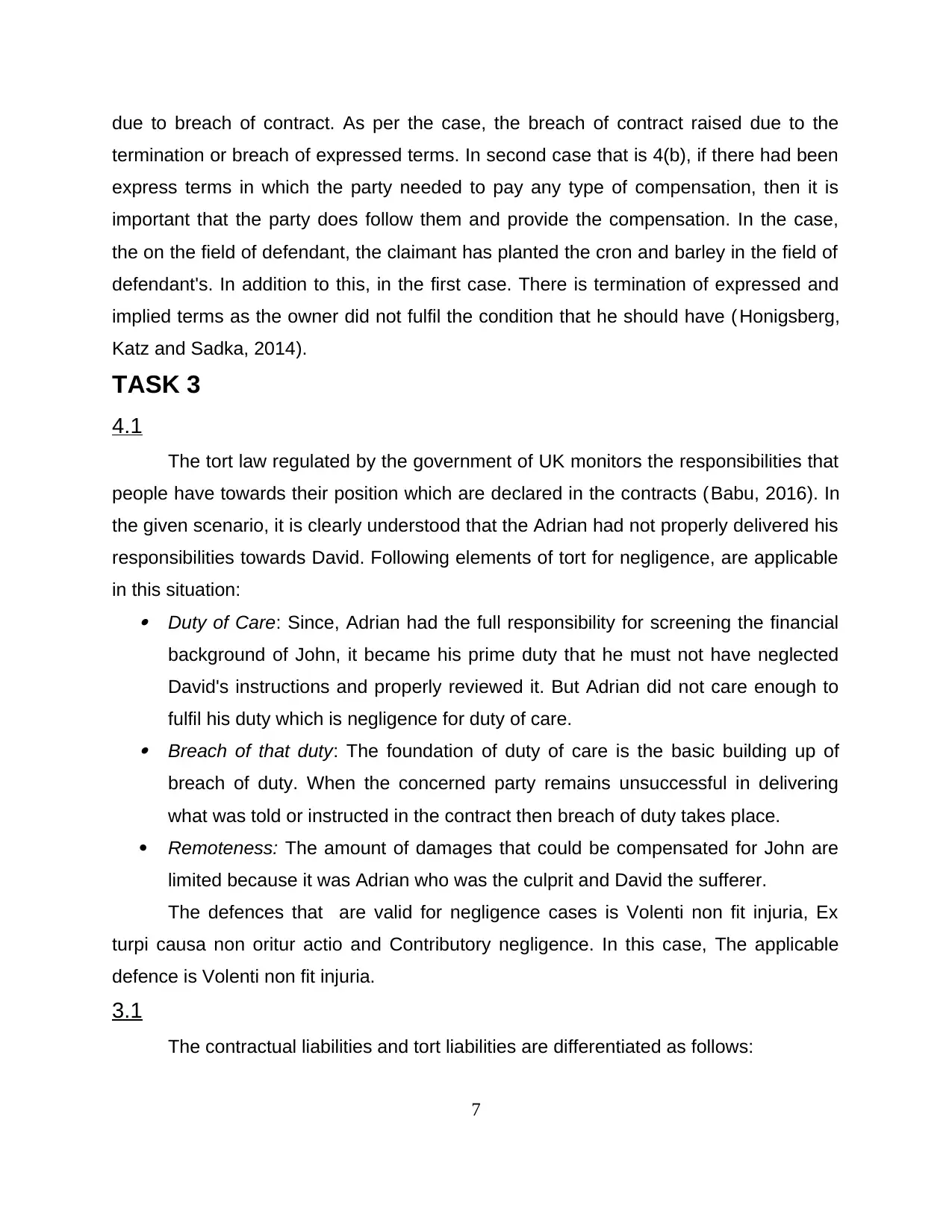
due to breach of contract. As per the case, the breach of contract raised due to the
termination or breach of expressed terms. In second case that is 4(b), if there had been
express terms in which the party needed to pay any type of compensation, then it is
important that the party does follow them and provide the compensation. In the case,
the on the field of defendant, the claimant has planted the cron and barley in the field of
defendant's. In addition to this, in the first case. There is termination of expressed and
implied terms as the owner did not fulfil the condition that he should have ( Honigsberg,
Katz and Sadka, 2014).
TASK 3
4.1
The tort law regulated by the government of UK monitors the responsibilities that
people have towards their position which are declared in the contracts (Babu, 2016). In
the given scenario, it is clearly understood that the Adrian had not properly delivered his
responsibilities towards David. Following elements of tort for negligence, are applicable
in this situation: Duty of Care: Since, Adrian had the full responsibility for screening the financial
background of John, it became his prime duty that he must not have neglected
David's instructions and properly reviewed it. But Adrian did not care enough to
fulfil his duty which is negligence for duty of care. Breach of that duty: The foundation of duty of care is the basic building up of
breach of duty. When the concerned party remains unsuccessful in delivering
what was told or instructed in the contract then breach of duty takes place.
Remoteness: The amount of damages that could be compensated for John are
limited because it was Adrian who was the culprit and David the sufferer.
The defences that are valid for negligence cases is Volenti non fit injuria, Ex
turpi causa non oritur actio and Contributory negligence. In this case, The applicable
defence is Volenti non fit injuria.
3.1
The contractual liabilities and tort liabilities are differentiated as follows:
7
termination or breach of expressed terms. In second case that is 4(b), if there had been
express terms in which the party needed to pay any type of compensation, then it is
important that the party does follow them and provide the compensation. In the case,
the on the field of defendant, the claimant has planted the cron and barley in the field of
defendant's. In addition to this, in the first case. There is termination of expressed and
implied terms as the owner did not fulfil the condition that he should have ( Honigsberg,
Katz and Sadka, 2014).
TASK 3
4.1
The tort law regulated by the government of UK monitors the responsibilities that
people have towards their position which are declared in the contracts (Babu, 2016). In
the given scenario, it is clearly understood that the Adrian had not properly delivered his
responsibilities towards David. Following elements of tort for negligence, are applicable
in this situation: Duty of Care: Since, Adrian had the full responsibility for screening the financial
background of John, it became his prime duty that he must not have neglected
David's instructions and properly reviewed it. But Adrian did not care enough to
fulfil his duty which is negligence for duty of care. Breach of that duty: The foundation of duty of care is the basic building up of
breach of duty. When the concerned party remains unsuccessful in delivering
what was told or instructed in the contract then breach of duty takes place.
Remoteness: The amount of damages that could be compensated for John are
limited because it was Adrian who was the culprit and David the sufferer.
The defences that are valid for negligence cases is Volenti non fit injuria, Ex
turpi causa non oritur actio and Contributory negligence. In this case, The applicable
defence is Volenti non fit injuria.
3.1
The contractual liabilities and tort liabilities are differentiated as follows:
7
Paraphrase This Document
Need a fresh take? Get an instant paraphrase of this document with our AI Paraphraser
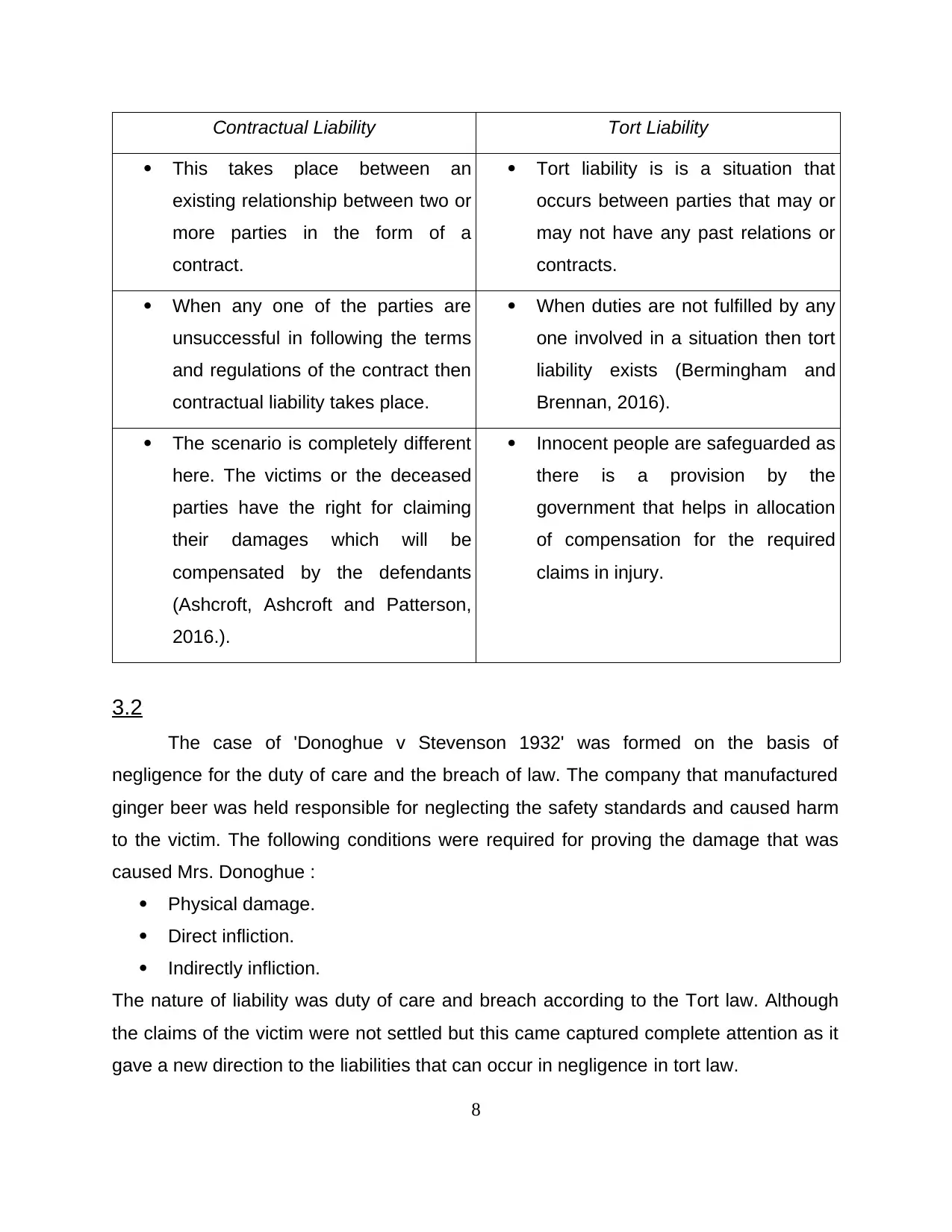
Contractual Liability Tort Liability
This takes place between an
existing relationship between two or
more parties in the form of a
contract.
Tort liability is is a situation that
occurs between parties that may or
may not have any past relations or
contracts.
When any one of the parties are
unsuccessful in following the terms
and regulations of the contract then
contractual liability takes place.
When duties are not fulfilled by any
one involved in a situation then tort
liability exists (Bermingham and
Brennan, 2016).
The scenario is completely different
here. The victims or the deceased
parties have the right for claiming
their damages which will be
compensated by the defendants
(Ashcroft, Ashcroft and Patterson,
2016.).
Innocent people are safeguarded as
there is a provision by the
government that helps in allocation
of compensation for the required
claims in injury.
3.2
The case of 'Donoghue v Stevenson 1932' was formed on the basis of
negligence for the duty of care and the breach of law. The company that manufactured
ginger beer was held responsible for neglecting the safety standards and caused harm
to the victim. The following conditions were required for proving the damage that was
caused Mrs. Donoghue :
Physical damage.
Direct infliction.
Indirectly infliction.
The nature of liability was duty of care and breach according to the Tort law. Although
the claims of the victim were not settled but this came captured complete attention as it
gave a new direction to the liabilities that can occur in negligence in tort law.
8
This takes place between an
existing relationship between two or
more parties in the form of a
contract.
Tort liability is is a situation that
occurs between parties that may or
may not have any past relations or
contracts.
When any one of the parties are
unsuccessful in following the terms
and regulations of the contract then
contractual liability takes place.
When duties are not fulfilled by any
one involved in a situation then tort
liability exists (Bermingham and
Brennan, 2016).
The scenario is completely different
here. The victims or the deceased
parties have the right for claiming
their damages which will be
compensated by the defendants
(Ashcroft, Ashcroft and Patterson,
2016.).
Innocent people are safeguarded as
there is a provision by the
government that helps in allocation
of compensation for the required
claims in injury.
3.2
The case of 'Donoghue v Stevenson 1932' was formed on the basis of
negligence for the duty of care and the breach of law. The company that manufactured
ginger beer was held responsible for neglecting the safety standards and caused harm
to the victim. The following conditions were required for proving the damage that was
caused Mrs. Donoghue :
Physical damage.
Direct infliction.
Indirectly infliction.
The nature of liability was duty of care and breach according to the Tort law. Although
the claims of the victim were not settled but this came captured complete attention as it
gave a new direction to the liabilities that can occur in negligence in tort law.
8
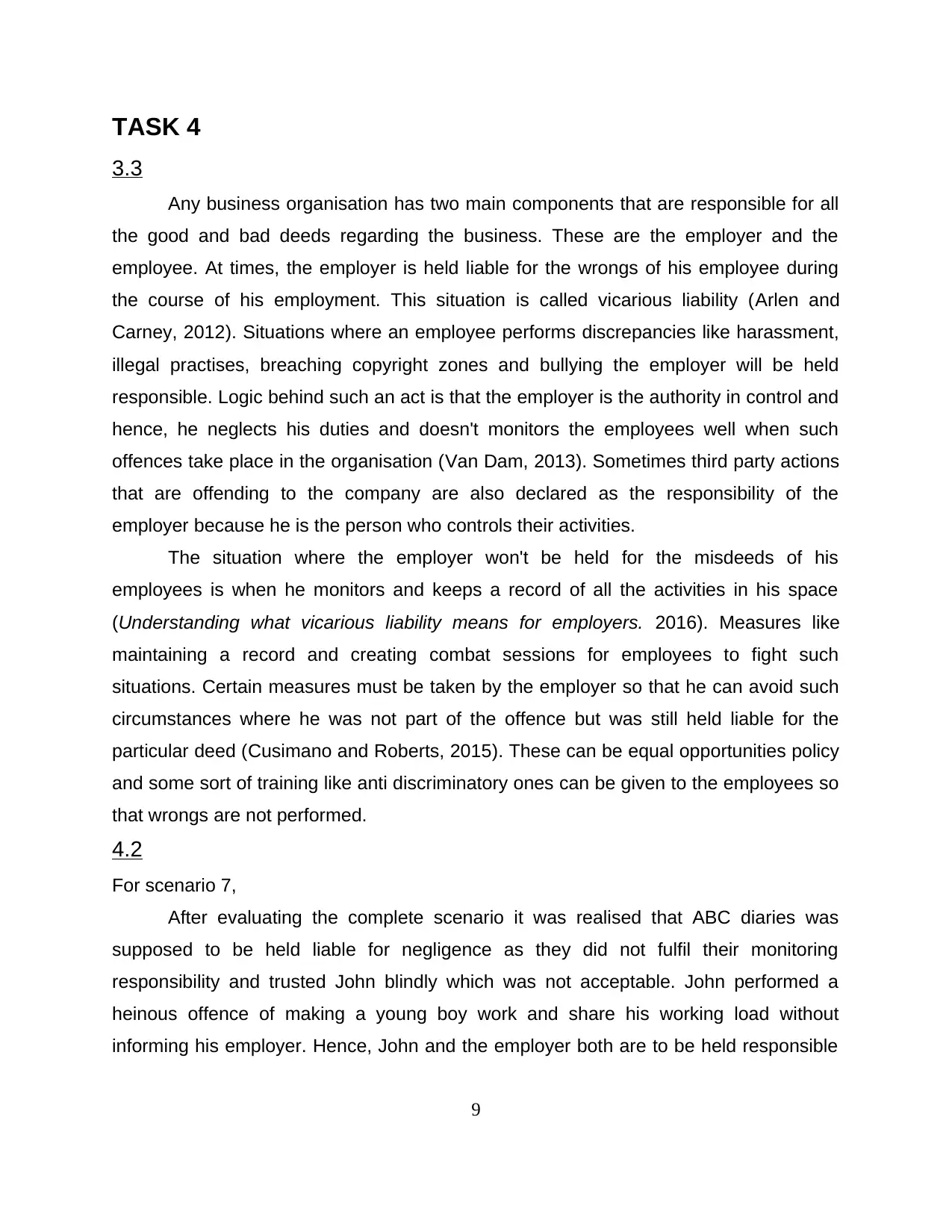
TASK 4
3.3
Any business organisation has two main components that are responsible for all
the good and bad deeds regarding the business. These are the employer and the
employee. At times, the employer is held liable for the wrongs of his employee during
the course of his employment. This situation is called vicarious liability (Arlen and
Carney, 2012). Situations where an employee performs discrepancies like harassment,
illegal practises, breaching copyright zones and bullying the employer will be held
responsible. Logic behind such an act is that the employer is the authority in control and
hence, he neglects his duties and doesn't monitors the employees well when such
offences take place in the organisation (Van Dam, 2013). Sometimes third party actions
that are offending to the company are also declared as the responsibility of the
employer because he is the person who controls their activities.
The situation where the employer won't be held for the misdeeds of his
employees is when he monitors and keeps a record of all the activities in his space
(Understanding what vicarious liability means for employers. 2016). Measures like
maintaining a record and creating combat sessions for employees to fight such
situations. Certain measures must be taken by the employer so that he can avoid such
circumstances where he was not part of the offence but was still held liable for the
particular deed (Cusimano and Roberts, 2015). These can be equal opportunities policy
and some sort of training like anti discriminatory ones can be given to the employees so
that wrongs are not performed.
4.2
For scenario 7,
After evaluating the complete scenario it was realised that ABC diaries was
supposed to be held liable for negligence as they did not fulfil their monitoring
responsibility and trusted John blindly which was not acceptable. John performed a
heinous offence of making a young boy work and share his working load without
informing his employer. Hence, John and the employer both are to be held responsible
9
3.3
Any business organisation has two main components that are responsible for all
the good and bad deeds regarding the business. These are the employer and the
employee. At times, the employer is held liable for the wrongs of his employee during
the course of his employment. This situation is called vicarious liability (Arlen and
Carney, 2012). Situations where an employee performs discrepancies like harassment,
illegal practises, breaching copyright zones and bullying the employer will be held
responsible. Logic behind such an act is that the employer is the authority in control and
hence, he neglects his duties and doesn't monitors the employees well when such
offences take place in the organisation (Van Dam, 2013). Sometimes third party actions
that are offending to the company are also declared as the responsibility of the
employer because he is the person who controls their activities.
The situation where the employer won't be held for the misdeeds of his
employees is when he monitors and keeps a record of all the activities in his space
(Understanding what vicarious liability means for employers. 2016). Measures like
maintaining a record and creating combat sessions for employees to fight such
situations. Certain measures must be taken by the employer so that he can avoid such
circumstances where he was not part of the offence but was still held liable for the
particular deed (Cusimano and Roberts, 2015). These can be equal opportunities policy
and some sort of training like anti discriminatory ones can be given to the employees so
that wrongs are not performed.
4.2
For scenario 7,
After evaluating the complete scenario it was realised that ABC diaries was
supposed to be held liable for negligence as they did not fulfil their monitoring
responsibility and trusted John blindly which was not acceptable. John performed a
heinous offence of making a young boy work and share his working load without
informing his employer. Hence, John and the employer both are to be held responsible
9
⊘ This is a preview!⊘
Do you want full access?
Subscribe today to unlock all pages.

Trusted by 1+ million students worldwide
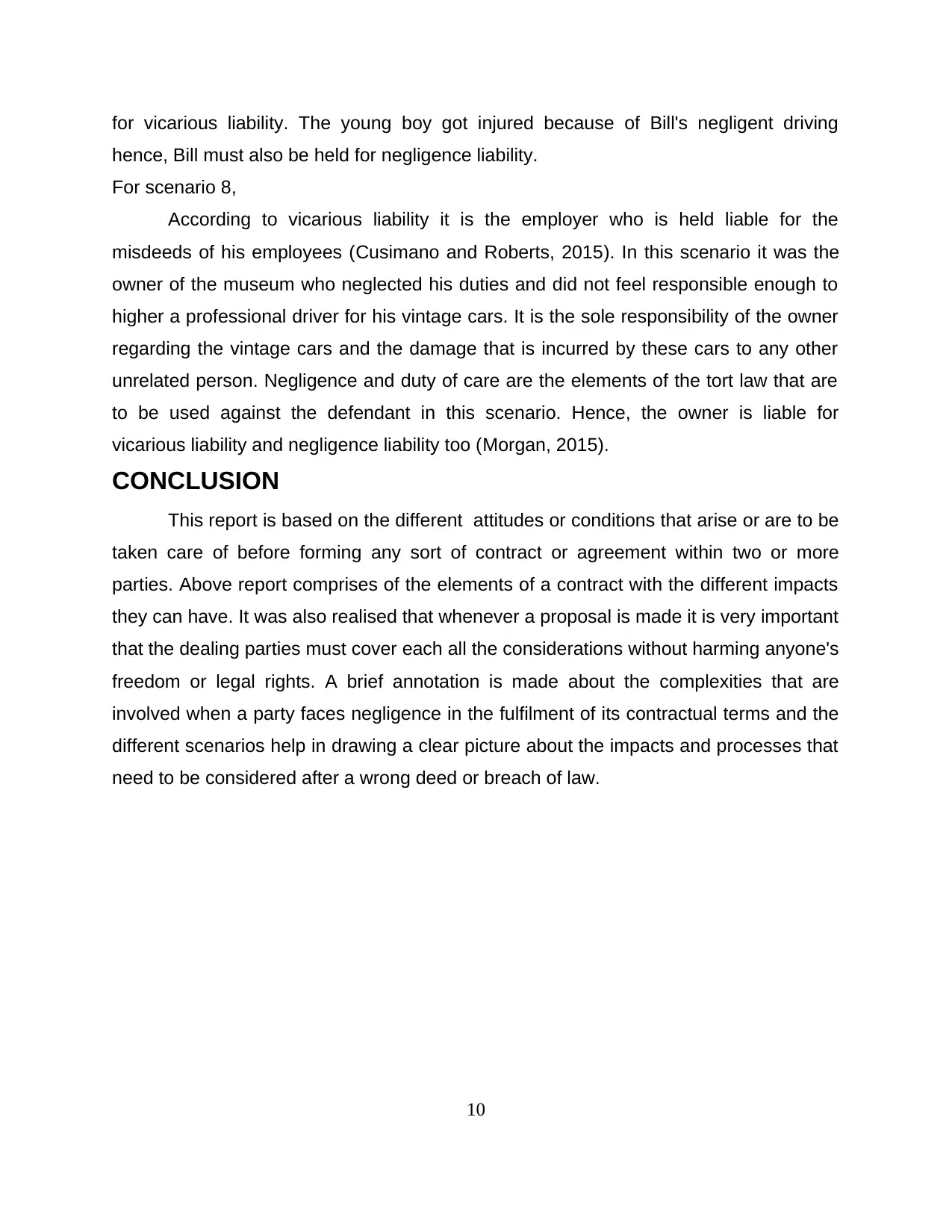
for vicarious liability. The young boy got injured because of Bill's negligent driving
hence, Bill must also be held for negligence liability.
For scenario 8,
According to vicarious liability it is the employer who is held liable for the
misdeeds of his employees (Cusimano and Roberts, 2015). In this scenario it was the
owner of the museum who neglected his duties and did not feel responsible enough to
higher a professional driver for his vintage cars. It is the sole responsibility of the owner
regarding the vintage cars and the damage that is incurred by these cars to any other
unrelated person. Negligence and duty of care are the elements of the tort law that are
to be used against the defendant in this scenario. Hence, the owner is liable for
vicarious liability and negligence liability too (Morgan, 2015).
CONCLUSION
This report is based on the different attitudes or conditions that arise or are to be
taken care of before forming any sort of contract or agreement within two or more
parties. Above report comprises of the elements of a contract with the different impacts
they can have. It was also realised that whenever a proposal is made it is very important
that the dealing parties must cover each all the considerations without harming anyone's
freedom or legal rights. A brief annotation is made about the complexities that are
involved when a party faces negligence in the fulfilment of its contractual terms and the
different scenarios help in drawing a clear picture about the impacts and processes that
need to be considered after a wrong deed or breach of law.
10
hence, Bill must also be held for negligence liability.
For scenario 8,
According to vicarious liability it is the employer who is held liable for the
misdeeds of his employees (Cusimano and Roberts, 2015). In this scenario it was the
owner of the museum who neglected his duties and did not feel responsible enough to
higher a professional driver for his vintage cars. It is the sole responsibility of the owner
regarding the vintage cars and the damage that is incurred by these cars to any other
unrelated person. Negligence and duty of care are the elements of the tort law that are
to be used against the defendant in this scenario. Hence, the owner is liable for
vicarious liability and negligence liability too (Morgan, 2015).
CONCLUSION
This report is based on the different attitudes or conditions that arise or are to be
taken care of before forming any sort of contract or agreement within two or more
parties. Above report comprises of the elements of a contract with the different impacts
they can have. It was also realised that whenever a proposal is made it is very important
that the dealing parties must cover each all the considerations without harming anyone's
freedom or legal rights. A brief annotation is made about the complexities that are
involved when a party faces negligence in the fulfilment of its contractual terms and the
different scenarios help in drawing a clear picture about the impacts and processes that
need to be considered after a wrong deed or breach of law.
10
Paraphrase This Document
Need a fresh take? Get an instant paraphrase of this document with our AI Paraphraser
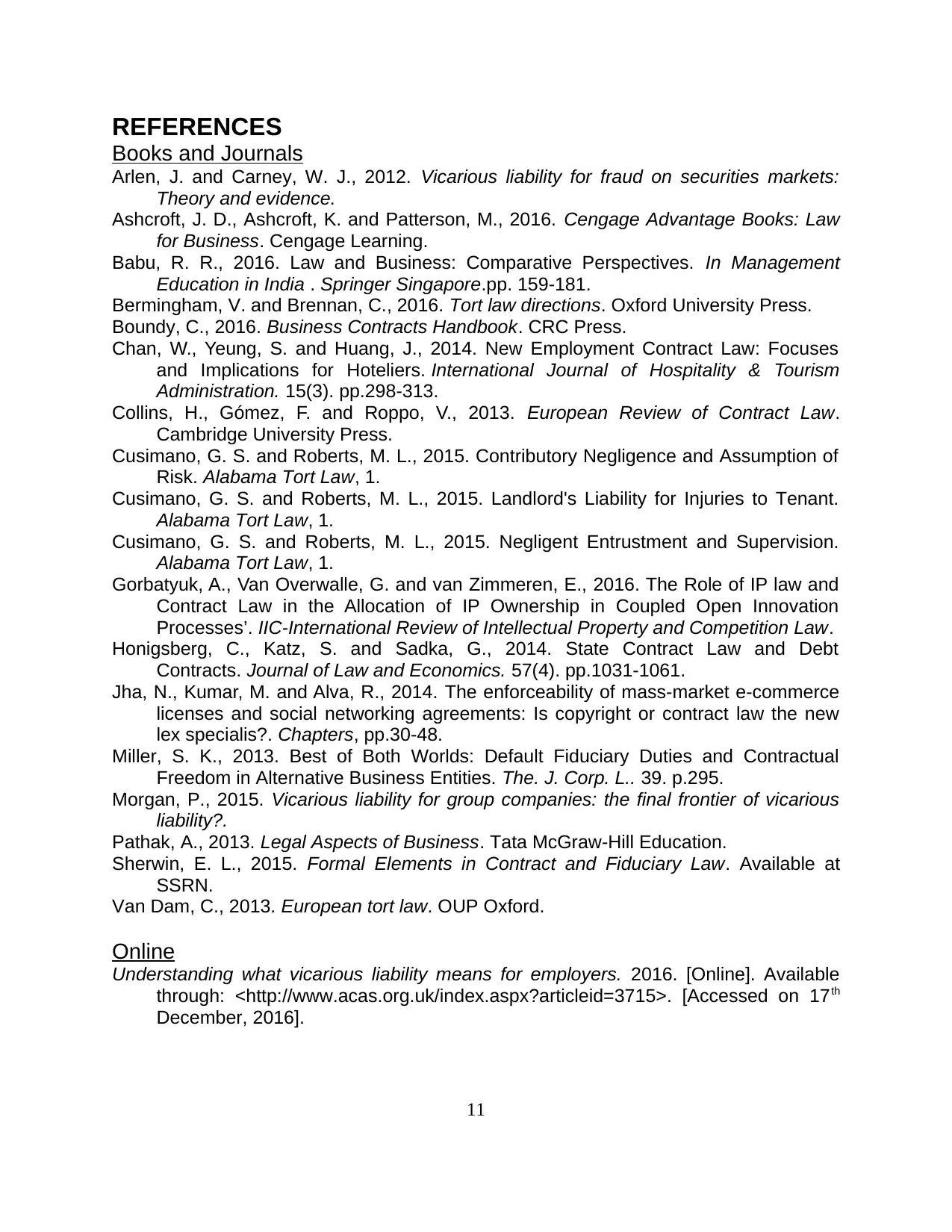
REFERENCES
Books and Journals
Arlen, J. and Carney, W. J., 2012. Vicarious liability for fraud on securities markets:
Theory and evidence.
Ashcroft, J. D., Ashcroft, K. and Patterson, M., 2016. Cengage Advantage Books: Law
for Business. Cengage Learning.
Babu, R. R., 2016. Law and Business: Comparative Perspectives. In Management
Education in India . Springer Singapore.pp. 159-181.
Bermingham, V. and Brennan, C., 2016. Tort law directions. Oxford University Press.
Boundy, C., 2016. Business Contracts Handbook. CRC Press.
Chan, W., Yeung, S. and Huang, J., 2014. New Employment Contract Law: Focuses
and Implications for Hoteliers. International Journal of Hospitality & Tourism
Administration. 15(3). pp.298-313.
Collins, H., Gómez, F. and Roppo, V., 2013. European Review of Contract Law.
Cambridge University Press.
Cusimano, G. S. and Roberts, M. L., 2015. Contributory Negligence and Assumption of
Risk. Alabama Tort Law, 1.
Cusimano, G. S. and Roberts, M. L., 2015. Landlord's Liability for Injuries to Tenant.
Alabama Tort Law, 1.
Cusimano, G. S. and Roberts, M. L., 2015. Negligent Entrustment and Supervision.
Alabama Tort Law, 1.
Gorbatyuk, A., Van Overwalle, G. and van Zimmeren, E., 2016. The Role of IP law and
Contract Law in the Allocation of IP Ownership in Coupled Open Innovation
Processes’. IIC-International Review of Intellectual Property and Competition Law.
Honigsberg, C., Katz, S. and Sadka, G., 2014. State Contract Law and Debt
Contracts. Journal of Law and Economics. 57(4). pp.1031-1061.
Jha, N., Kumar, M. and Alva, R., 2014. The enforceability of mass-market e-commerce
licenses and social networking agreements: Is copyright or contract law the new
lex specialis?. Chapters, pp.30-48.
Miller, S. K., 2013. Best of Both Worlds: Default Fiduciary Duties and Contractual
Freedom in Alternative Business Entities. The. J. Corp. L.. 39. p.295.
Morgan, P., 2015. Vicarious liability for group companies: the final frontier of vicarious
liability?.
Pathak, A., 2013. Legal Aspects of Business. Tata McGraw-Hill Education.
Sherwin, E. L., 2015. Formal Elements in Contract and Fiduciary Law. Available at
SSRN.
Van Dam, C., 2013. European tort law. OUP Oxford.
Online
Understanding what vicarious liability means for employers. 2016. [Online]. Available
through: <http://www.acas.org.uk/index.aspx?articleid=3715>. [Accessed on 17th
December, 2016].
11
Books and Journals
Arlen, J. and Carney, W. J., 2012. Vicarious liability for fraud on securities markets:
Theory and evidence.
Ashcroft, J. D., Ashcroft, K. and Patterson, M., 2016. Cengage Advantage Books: Law
for Business. Cengage Learning.
Babu, R. R., 2016. Law and Business: Comparative Perspectives. In Management
Education in India . Springer Singapore.pp. 159-181.
Bermingham, V. and Brennan, C., 2016. Tort law directions. Oxford University Press.
Boundy, C., 2016. Business Contracts Handbook. CRC Press.
Chan, W., Yeung, S. and Huang, J., 2014. New Employment Contract Law: Focuses
and Implications for Hoteliers. International Journal of Hospitality & Tourism
Administration. 15(3). pp.298-313.
Collins, H., Gómez, F. and Roppo, V., 2013. European Review of Contract Law.
Cambridge University Press.
Cusimano, G. S. and Roberts, M. L., 2015. Contributory Negligence and Assumption of
Risk. Alabama Tort Law, 1.
Cusimano, G. S. and Roberts, M. L., 2015. Landlord's Liability for Injuries to Tenant.
Alabama Tort Law, 1.
Cusimano, G. S. and Roberts, M. L., 2015. Negligent Entrustment and Supervision.
Alabama Tort Law, 1.
Gorbatyuk, A., Van Overwalle, G. and van Zimmeren, E., 2016. The Role of IP law and
Contract Law in the Allocation of IP Ownership in Coupled Open Innovation
Processes’. IIC-International Review of Intellectual Property and Competition Law.
Honigsberg, C., Katz, S. and Sadka, G., 2014. State Contract Law and Debt
Contracts. Journal of Law and Economics. 57(4). pp.1031-1061.
Jha, N., Kumar, M. and Alva, R., 2014. The enforceability of mass-market e-commerce
licenses and social networking agreements: Is copyright or contract law the new
lex specialis?. Chapters, pp.30-48.
Miller, S. K., 2013. Best of Both Worlds: Default Fiduciary Duties and Contractual
Freedom in Alternative Business Entities. The. J. Corp. L.. 39. p.295.
Morgan, P., 2015. Vicarious liability for group companies: the final frontier of vicarious
liability?.
Pathak, A., 2013. Legal Aspects of Business. Tata McGraw-Hill Education.
Sherwin, E. L., 2015. Formal Elements in Contract and Fiduciary Law. Available at
SSRN.
Van Dam, C., 2013. European tort law. OUP Oxford.
Online
Understanding what vicarious liability means for employers. 2016. [Online]. Available
through: <http://www.acas.org.uk/index.aspx?articleid=3715>. [Accessed on 17th
December, 2016].
11
1 out of 11
Related Documents
Your All-in-One AI-Powered Toolkit for Academic Success.
+13062052269
info@desklib.com
Available 24*7 on WhatsApp / Email
![[object Object]](/_next/static/media/star-bottom.7253800d.svg)
Unlock your academic potential
Copyright © 2020–2025 A2Z Services. All Rights Reserved. Developed and managed by ZUCOL.





